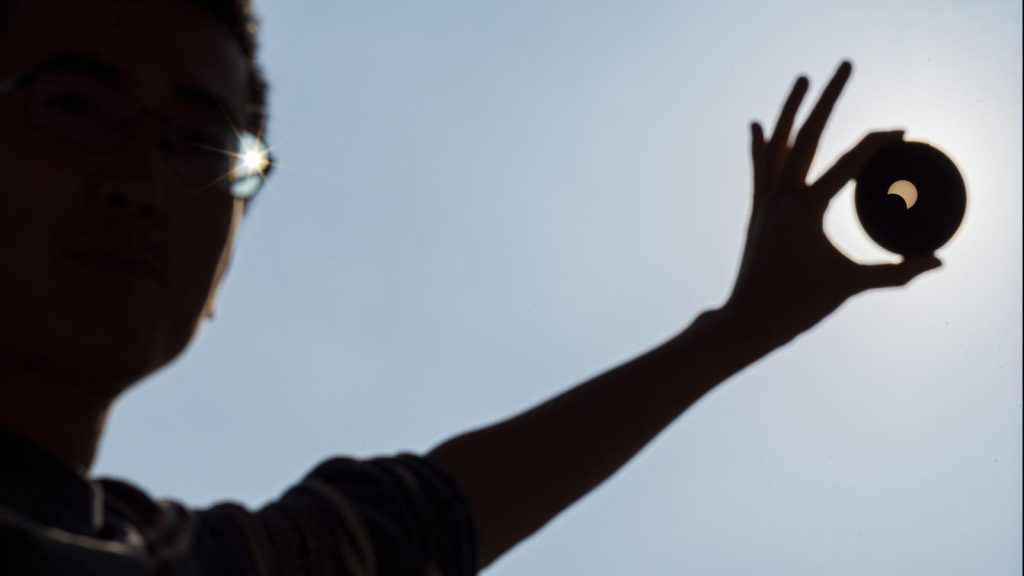If you’re planning to witness the total solar eclipse from within the narrow 115 miles wide path of totality on Monday, April 8, knowing what to expect and how to make the most of the experience is essential. Eclipse-chasers have their unique ways of enjoying the event, from knowing when to go pee to how to scan the totally eclipsed sun for incredible sights. Here’s a closer look at the things experienced eclipse-chasers will secretly do (and not do) on Monday:
NOTE: This article only applies to those that are in the path of totality, which is set out in this map (below). If you’re not within the path of totality (which you can check on this interactive map, this eclipse simulator and in this eclipse look-up then you’ll see just a partial solar eclipse, which requires solar safety glasses at all times and is not rare or unusual.
1. Barely Look At The Partial Phases
There is so much fuss about solar safety glasses that many (most?) people think that without them it’s dangerous to go outside. However, eclipse-chasers barely use them. If you’re within the path of totality, then the main attraction is not to see the sun partially eclipsed by the moon (yawn!), but the totally eclipsed sun, which is perfectly safe to look at and no brighter than a full moon.
Eclipse-chasers are waiting for that moment, so aside from a quick glance through solar safety glasses to see how the moon is progressing across the sun, they’ll barely look. In fact, the most important thing about “C1” or “First Contact”—when the moon begins to eclipse the sun—is that this is the ideal moment to go find a restroom. After all, there’s only about 75 minutes to go!
2. Record Audio
So many would-be eclipse observers make a fuss about photographing totality. Sure, there are professionals out there who are past masters. As well as that alone being a good argument why not to bother yourself, it’s also a fact that the most memorable thing about experiencing totality is the atmosphere. This is best captured by audio. Set your smartphone to record audio just before totality and leave it running, asking people for their on-the-spot reactions right after totality. It’s a recording you will cherish forever‚ unlike that photo you painstakingly took at the cost of missing the actual eclipse … that will look more or less the same (if you’re lucky) as the official NASA images published a few hours later.
3. Take A Silhouette Selfie
The only image worth taking that will truly take you back to the experience of totality isn’t an image of the eclipse itself, but of you and your companions watching it together. An image of your silhouette watching the eclipse is something to treasure. It’s best created by putting your smartphone on a small tripod behind you, setting it to wide-angle and letting it record a 4K video. Then you have audio and video in one—and you can easily extract a still image later.
4. Use Binoculars
Absolutely any pair of binoculars will do—but you need to know when and when not to use them. Find some, borrow some and put them around your neck. Aside from focusing them on something far away before the eclipse, you can forget all about them until it goes dark and totality begins. Put them up to your eyes and … wow! The solar corona in close-up is something to behold—and it’s no brighter than a full moon. If you plan to use them to inspect the partial phases, you MUST use special solar filters on the objective lenses of your binoculars. ONLY use them on the eclipse when it’s total and no part of the sun’s bright disk is showing. If you want to be extra safe, wait until it’s really dark and just use them for 30 seconds or a minute (depending on how long totality will last where you are).
5. Talk About The Sun As A Clockface
“Prominences, 3 o’clock!” or similar is a common refrain from those in the know during totality. If you hear it, think of the sun as a clock face and look at where the imaginary clock hand would be. Your reward will be prominence, an astronomical name for a large, bright feature extending outward from the sun’s surface. They look bright pink during totality and extend into the corona. They are a sight to behold! As with the last total solar eclipse on April 20, 2023, prominences can sometimes appear as loops.
6. Dark-Adapt Eyes Before Totality
Not all eclipse-chasers do this, but some swear to buy it. Put a patch over one eye or wear red welders’ goggles in the hour or so before totality. When totality starts, remove them, and you’ll have dark-adapted eyes. You’ll see the solar corona look larger and brighter than anyone else around you. The sacrifice is not seeing the partial phases beforehand—but that’s OK because you can check that out after totality as the eclipse goes into reverse.
7. Shed A Few Tears
The moments of totality are rare and, for many, involve huge sacrifices to reach. Eclipse-chasers travel huge distances at great expense. Why? Totality can be a waymarker in human life; it’s a moment with such power and splendor that it can be as important and as impactful as births, deaths, and marriages in a person’s life. When you look back on your life, it’s one of the few moments you’ll remember with clarity. So if you see people crying—whether they just experienced a beautiful totality or, worse, it clouded out, and they missed something they know to be so special—don’t be surprised. Be jealous that they’ve found a way to directly connect with nature.
I’m an expert on eclipses—the editor of WhenIsTheNextEclipse.com and author of The Complete Guide To The Great North American Eclipse of April 8, 2024. For the very latest on the total solar eclipse—including travel and lodging options—check my main feed for new articles each day.
Wishing you clear skies and wide eyes.
Read the full article here





